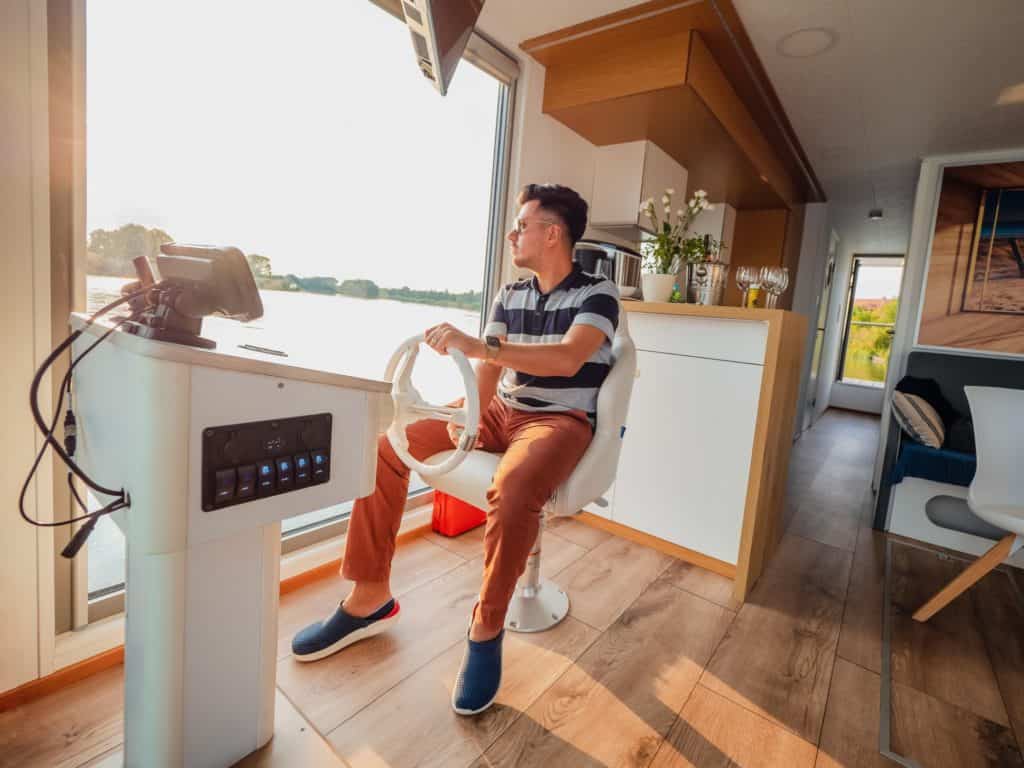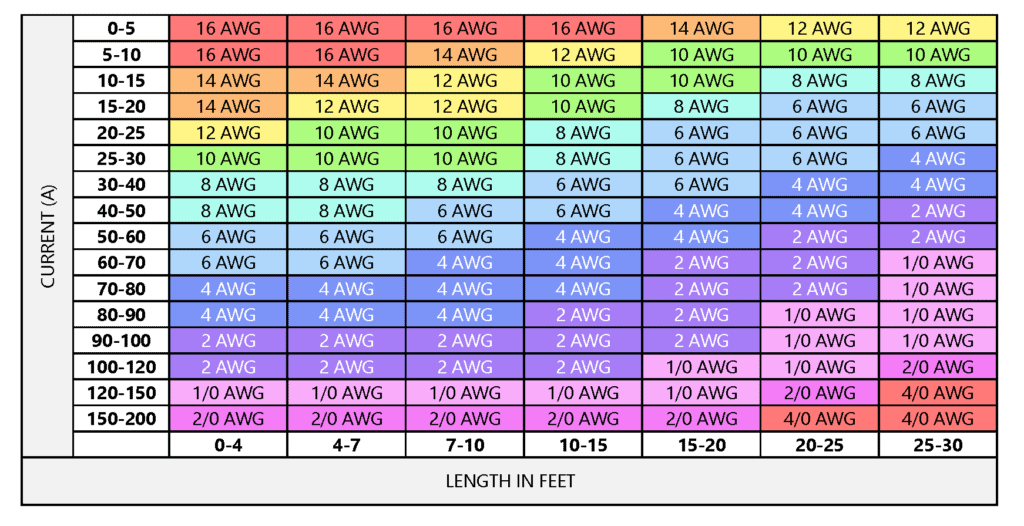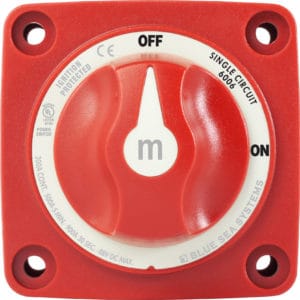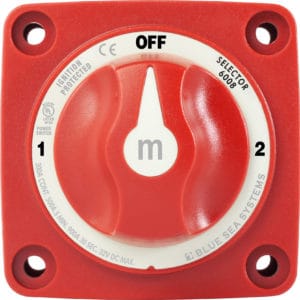House Boats
Houseboats can give you a motorized or non-motorized method of living and playing on the water. They are ideal for spending long periods of time aboard with many modern comforts. The large, flat roof is a perfect space for solar panels that can keep a battery bank charged up. This allows deliverable power from your houseboat batteries to your appliances, electronics, and more.
With a bank of Battle Born lithium batteries, you’re able to supply your houseboat with two to three times more power than lead-acid batteries at a fraction of the weight.
A typical lead-acid battery cannot be drained below 50% of its capacity without significant damage being inflicted. Our deep cycle LiFePO4 houseboat batteries allow you to use 100% of your battery’s capacity without fear of damage or memory.

Why Lithium Batteries Work Great On Houseboats
Houseboats offer so many exciting and unique features that you probably don’t want to think about your houseboat batteries. While they may not be the most exciting aspect of your vessel, they’re among several critical systems that can make noticeable differences in your onboard lifestyle and comfort level. That’s why it’s vital to consider lithium batteries for your houseboat. Let’s shine a light on a few reasons why.
How Does a Houseboat Get Electricity?
Houseboats stay on the grid through a few different methods. The easiest and most powerful is the aptly named shore power. This refers to any connection from your houseboat to the traditional electrical grid. You’ll essentially “plug in” your boat to hookups at a marina or dock and enjoy electricity as usual.

You can also generate your own electricity for the sake of convenience, the environment, or both! Houseboats may have gasoline-powered generators as well. These provide quick and often powerful electricity but rely on a finite gas supply to operate. Once that runs out, you’re stuck in the dark.
A renewable and greener option is solar power, wind power, or both. Solar power uses solar panels to convert the sun’s energy into electricity stored in a battery bank or used immediately. Wind power does the same with the wind using a windmill and wind turbine. Both may be more expensive to set up initially but require no fuel other than the world around you.
Finally, houseboats can draw electricity from onboard batteries. These come in many different types and styles over a wide price range. You can charge these batteries when you plug into shore power or otherwise generate more electricity than you actually use.
Just note that to run many typical appliances on battery power, you’ll need an inverter to create the proper voltage.
What Do Batteries Power on a Houseboat?
Houseboat batteries will generally provide the 12V electricity to power your most essential systems when not connected to shore power. These typically include lights, radio, water pump, and other low-voltage appliances or 12V outlets. With the help of an inverter to step up the voltage, your batteries can power just about anything you can put on your boat. This includes traditional outlets, TVs, air conditioners, and more.
The Benefits of Using Lithium for Houseboat Batteries
Lead-acid batteries may be cheaper upfront and more readily available. However, lithium batteries are considered the top option for many houseboaters, whether you’re a full-time or casual sea dweller. Here are some noteworthy reasons.
More Power, Less Weight
Weight is a concern for nearly all modes of transportation, and houseboats are no exception. All houseboats have a set limit for how much weight they can carry. Every pound you use on houseboat batteries is one pound fewer available for possessions or other valuable systems you could add.
Lithium batteries typically weigh far less than almost any regular lead-acid battery and are miles ahead regarding how much energy they can store at a given weight. Switching from lead-acid to lithium means you can either free up the weight on your boat or store significantly more energy than you had previously while keeping the same weight.

Smaller Size to Store
In addition to storing more and weighing less, lithium houseboat batteries are also physically smaller than comparable lead-acid ones. The tiniest spaces can make a big difference in applications like houseboats, RVs, and other small areas. Once again, it all comes back to one of the most significant lithium advantages–much better efficiency by weight and volume.
Use 100% Battery Capacity
A significant downside of traditional batteries is that you cannot fully discharge them. If you use their total stored energy, you will damage them. In fact, you can’t discharge them below 50% without permanently damaging them. That’s half your battery’s capacity functionally unavailable due to the nature of lead-acid batteries.
Lithium batteries operate fundamentally differently. Among the advantages, you can use every bit of energy stored, and your batteries will work perfectly fine once recharged. Think about all the extra usage this would mean regularly.
Longer Lasting Batteries
It’s true–lithium batteries are more expensive than their lead-acid counterparts upfront. But that difference disappears when you consider the long run. Lithium batteries last hundreds or thousands more charging cycles than traditional batteries, meaning years of additional usage.
Monetary savings aside, buying and replacing your batteries is rarely anyone’s idea of a good time. Lithium batteries let you spend less time maintaining your houseboat and more time enjoying it.

Where Do You Store Lithium Batteries on a Houseboat?
The most straightforward answer is that you’ll most likely store your lithium houseboat batteries in the same location your current batteries occupy. Although, they’ll usually take up less space.
Unlike their lead-acid counterparts, lithium batteries don’t off-gas or require venting. This means you can install them anywhere! Because they are so much safer than lead-acid, you can put them practically anywhere you have space and makes sense for your electrical system – even if it’s under your bed.
Is It Easy to Install Lithium Batteries on Your Houseboat?
For those with some electrical experience, lithium batteries aren’t challenging to install. However, you should have a suitable battery management system (BMS) and upgrade any other necessary components. Battle Born Batteries come with a built-in BMS so you don’t have to worry about anything.
Our helpful tech support team is always happy to walk through your system. They’ll help you understand any other upgrades that are needed to make the switch from lead-acid.
Is Installing Lithium Batteries on Your Houseboat Worth It?
Whether or not it’s worth it to switch your houseboat batteries to lithium will depend greatly on how you use your boat. If your houseboat is mainly a vacation spot or tends to stay hooked up to shore power in the same place all the time, it may not make financial sense to upgrade. Those who’ve recently purchased new lead-acid batteries may also wish to wait until their current batteries run out before making any changes.
But for full-time houseboat residents, frequent travelers, or those with heavy power needs, an upgrade to lithium houseboat batteries is wise. You can take advantage of all that lithium houseboat batteries offer and face fewer of the already-limited downsides.
Overall, lithium batteries and houseboats can truly be a match made in heaven. Despite their higher initial cost, this versatile technology pays for itself over time, as this will probably be the last battery bank your houseboat will ever need.
They also allow boat owners to reduce battery weight and size. It also provides additional energy storage and reduces maintenance needs.
These are just a few reasons lithium houseboat batteries provide many users incredible value over the long term and are worth considering for just about all boat owners.
Are you thinking about making a change to lithium batteries on your houseboat? Call our Nevada-based tech and customer service line to discuss your project with our expert lithium battery tech at 775-622-3448.
Houseboat FAQs
Why choose Battle Born?
Last 10 Times Longer than Lead Acid
Even after 3000 – 5000 life cycles Battle Born Batteries retain 75 – 80% of their original capacity. For most users, it will take 10 to 15 years to reach this amount of life cycles.
2 to 3 times more power
Our batteries will supply you with two to three times the power in the same physical space of a lead acid battery.
Charge 5 Times Faster
With a high charge rate of half of your total bank and short absorption times, your batteries will charge in a fraction of the time of a lead acid. This faster charge rate allows you to use your generator less which means less fuel consumption, less noise, and less pollution.
High Discharging Capabilities
Our 100 Ah batteries provide a continuous 100 amps of power, surge of up to 200 amps for 30 seconds and even higher loads for a ½ second.
Efficient and High Performance
Our batteries have virtually no internal resistance and will not heat up or swell when charging or discharging. We also have a real power rating so whether you’re using 1 amp for 100 hours or 100 amps for one hour, you will receive the full amount of power your batteries are rated for. With a very flat discharge curve, power remains much more consistent with Battle Born Batteries even at a low state of charge.
Environmentally Safe and Non-Toxic
One lead acid battery can contaminate acres of municipal waste, but Battle Born Batteries are not toxic and are made with the safest lithium chemistry on the market. This allows you to place them anywhere in your rig whether it’s under a bed, a dinette, or even a small enclosed area without the fear of our batteries “off gassing” like lead acid.
Lighter
Our batteries are ½ to ⅔ the weight of a standard lead acid battery with more deliverable power.
Maintenance Free
Battle Born Batteries have a built-in management system to help protect you and your investment in the batteries in any strenuous situations such as high/low temperatures, high/low voltages, current surges, and short circuits. They also can be placed in your system with zero maintenance, so you no longer have to worry about adding water to your batteries or cleaning corroded terminals. Our batteries also have a very slow self-discharge rate so they can be left in storage for over a year without requiring you to hook them up to a trickle charger.
Customer Service
We employ a team of USA-based experts at Battle Born Batteries to help with your customer service, sales and technical needs. Our industry-leading team utilizes clear communication via phone and email, along with product knowledge and problem-solving skills to assist with any questions you may have along the way. Whether you’re looking to upgrade your batteries, a complete power system or anything in between our team can provide the expertise needed to guide you through a lithium conversion. Feel free to contact our team at (855) 292-2831 or [email protected].
10-Year Warranty
We believe in our batteries and we want you to believe in them too. That’s why we ship every battery out with a 10-year warranty. If you have a problem, we want to fix it as quickly as possible so you can go on your next adventure!
Excellent Solar Systems
Battle Born Batteries allow you to take full advantage of solar by creating fast charging and fully sustainable power systems with a variety of applications.
How much do your batteries weigh?
Battle Born Batteries are 1/5th the weight of a traditional lead acid battery when matching the same usable capacity. This can result in a significant reduction in gross vehicle weight, not to mention being easier to load, install or move if necessary.
BB10012 and BBGC2 (12 volt 100 Ah) – 31 pounds
BB5012 (12 volt 50 Ah) – 17 pounds
BB5024 (24 volt 50 Ah) – 31 pounds
How do I size a li-ion battery bank for my system?
Sizing a battery bank for an off-grid or mobile power system can get complicated if you don’t have all the information you need to make the right calculations. You will need some basic information to get started.
You will need the maximum and continuous draw – in amps or watts – of the devices you want to power. These are usually found somewhere on the device on a sticker or plate that shows the amps and volts of that device or the power in watts.
As an example, let’s just say that our system needs to run 10 amps at 120 volts for 3.5 hours.
10 amps x 120 volts = 1200 watts of power.
1200 watts x 3.5 hours = 4200 watt-hours of energy.
Next you need to convert 4200 watts-hours to direct current (DC) amp-hours. For our example, we will use a 12 volt battery bank.
4200 watts-hours / 12 volts = 350 DC amp-hours of battery energy needed for our sample application.
Also, the battery needs to be able to deliver 1200 watts/ 12 volts = 100 amps of power.
We will use the 100 amp-hour Battle Born battery to build this system.
350 amp-hours / 100 amp-hours = 3.5
We would need to use four 100 amp-hour LiFePO4 Battle Born Batteries to power this system.
Are there any temperature restrictions on Battle Born Batteries?
Battle Born Batteries protect themselves from charging in cold temperatures and won’t accept a charge once the internal cell temperature drops to 24°F. At this point they will continue to discharge even down to -4°F. At this temperature we recommend no longer pulling power to avoid damaging the batteries.
Insulated battery boxes, heating blankets, and placing your battery bank inside your RV will help keep the temperature stable. On the high end of temperature range, the batteries will shut down once 135°F is reached.
Do I need to install all of my batteries at the same time, or can I add additional batteries later?
Lead acid battery manufacturers will state: “do not mix old and new batteries. Doing so will reduce overall performance and may cause battery leakage or rupture.” They also recommend replacing all batteries within a bank at the same time.
A partially used lead acid battery will drain energy from a new one, reducing the total amount of battery power available.
This is not the case with Battle Born LiFePO4 batteries. You can add new batteries to your original Battle Born bank up to two years down the road without damaging, reducing lifespan, or harming them in any way.
What is the maximum amperage I can charge my batteries at?
Our batteries allow a max of 50 amps for each 100 Ah battery. For more than one battery you can simply take the entire Ah of the bank and cut the number in half.
For example, three 100 Ah Battle Born batteries total 300 Ah. Cut this number in half and you have your max recommended charge rate of 150 amps.
What does "drop-in replacement" actually mean?
Our batteries are drop-in replacements for typical lead acid batteries. This means that our batteries are designed to fit like a normal Group 27, 31 and GC2 battery in your bank.
This, however, does not mean our batteries are plug and play. Our batteries still may require specific components and programming to run your application.
To figure out if your components will work with our batteries, give us a call at (855) 292-2831 or send us an email at [email protected].
How long do Battle Born Batteries last?
Why is my battery registering a voltage between 0-5 volts?
If your battery registers between 0 to 5 volts this means that it’s in low voltage disconnect mode. This happens if the battery has been drained of capacity and is protecting itself from further discharge.
At this point you will need to apply a direct 12 V source such as the alternator via the starter battery or by connecting it to your starter battery with jumper cables until you see the voltage reaches 10-10.5 V.
Some inverter chargers will also bring the batteries out of low voltage disconnect.
Are my charging devices compatible with your batteries?
To determine whether your devices are compatible with BB batteries, take a look at the manual for each component and look at the specifications.
If the charging specs in the manual match up with the charging voltage of 14.4-14.6 V and the float voltage: 13.6 V or lower, then they are compatible with our batteries.
If you can adjust settings (such as a custom profile) on your devices to various charging and float voltages, then change the settings to match ours.
You are also more than welcome to give us a call at (855) 292-2831 or contact us at [email protected].
How do I know what size cables to use with my system?
When considering cable sizing there are a few factors to consider.
First, what is the size of the load you are powering with the battery bank?
Second, how far away from the battery is the load? You can do voltage drop calculations to see if you need to step up your cable size.
Here is an easy reference chart:
As a rule of thumb, you can use these numbers as a guideline.
-4 AWG wire approximate max rating is 157 amps DC
-1/0 AWT wire approximate max rating is 291 amps DC
-4/0 AWT wire approximate max rating is 456 amps DC
How do I protect against a high voltage spike back?
When current is flowing and abruptly stopped or interrupted, there is a potential for a high frequency voltage spike or pulse. Normally this voltage spike is an unwanted feature, as it tends to damage MOSFETs or other solid-state switches and relay contacts.
Alternator Protection Device
An alternator protection device, also known as a snuffer, is meant to protect a vehicles alternator if a spike is created. This device gives the spike a route to safely discharge without risk of damaging the alternator.
Issues such as loose wires, blown fuses or a running engine switching off can be some common sources of a voltage spike. The alternator protection device is a cost–effective way to protect a very expensive part of your vehicles charging system.
Sterling Power makes a 12 V and 24 V alternator protection device that can be installed on all vessels utilizing an alternator as a primary charging source.
What type of inverter do I need?
Selecting an inverter can be confusing due to the differing variations, styles and qualities available in stores and on the internet.
What is an inverter?
One of the primary functions of an inverter is to take direct current (DC) power and invert it into 120 volts, for using appliances. This can be through a wall receptacle or directly from the inverter.
Many all-in-one units allow a pass-through from shore power or genset, a high amperage DC charger and transfer switch.
What else should I know?
We recommend inverters that have a “pure” or “true” sine wave as the “modified” or “square” wave inverters are harder on components, cause more heat and can lead to damage to sensitive electronics over longer periods of time. Victron, Magnum, Xantrex, ProMariner and Mastervolt are some examples of high quality units that are used in many marine applications.
One of the most important things to consider is your maximum need in wattage at any given time. Take a look at the wattage specifications on your devices and consider which of these you will be using at the same time and add them together.
For example, If your power need is 1600 watts then round up to a 2000 watt inverter. When choosing an multi-function inverter, consider how much of a maximum charge you will require for your bank of batteries.
Upon request we will program your Victron inverter charger for the number of Battle Born Batteries in your bank at no charge.
Does my inverter need to be in a ventilated area, so it doesn't overheat?
Many inverter manufacturers recommend that you have some space around inverter sides and top or bottom for air flow. This will allow the internal fans to circulate air within a compartment and properly cool your inverter when necessary.
Please check your specific manufacturers recommendations and user manuals for further details.
Do I need a shutoff switch for your batteries?
Battery switches or “master disconnect” switches are a common item in RV or marine systems and used to cut all power from a battery bank and connected loads.
These devices are very versatile and can be used in any circuit when performing maintenance or an emergency shut down. Very often you will see placement of these switches between inverter(s) and a bank of batteries.
Below are some of the most common styles:
Single on/off
3 position – used to shut off or switch from one bank of batteries to a second
4 position – used to shut off, switch from one bank to a second or combine the two
Do I need a BIM or a battery to battery charger?
Battery Isolation Manager
The battery isolation manager (BIM) is typically used in motorized systems with 3 or more Battle Born Batteries. Lithium batteries tend to pull a lot of power off your alternator, which over time could cause it to overheat.
The BIM works on a duty cycle. It charges your house battery bank for 15 minutes, then taking 20 minutes to rest so your alternator can take a break and never has the opportunity to overheat.
Battery to Battery Charger
Battery to battery chargers are typically used in applications where you have 1 or 2 Battle Born Batteries. This is because our batteries have a recommended 50 amp charge rate per battery. If your alternator is applying a higher amperage to your batteries than the recommended charge rate, you will need to limit the amperage.
The battery to battery charger will limit the amperage coming off your alternator and will apply a safe charge to your batteries.
Both devices will properly isolate your lithium batteries from your starting battery.
How many solar panels do I need to charge my batteries?
Answering this question can depend on the amount of space you have on your vehicle and how fast you want your bank to charge.
As a general guideline we recommend 200 to 250 watts of solar per 100 amp-hours of battery. This will give you the ability to charge from nearly empty to full in a six to eight-hour time frame.
Many factors can change this calculation and you are invited to call at (855) 292-2831 or email us at [email protected] if you would like to discuss in greater detail.
Which Victron solar charge controller do I need?
Many RVers run into trouble when deciding which solar charge controller to choose. There are many models with varying voltage and amperage ratings. Which one is right for your application?
Victron’s “Blue Solar” model is a set and forget controller without readouts or internal Bluetooth.
Victron’s “Smart Solar” is a Bluetooth version with viewable information on the “Victron Connect” application from your mobile device.
Second, decide how many watts of panels you want in your solar array and take a look at our compatibility table to determine the product that best fits your system here.
Upon request we will program your Victron solar charge controller for the number of Battle Born Batteries in your bank at no charge.




